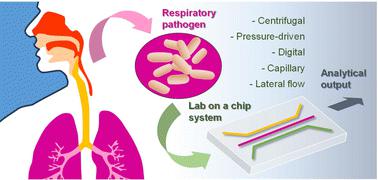Our official English website, www.x-mol.net, welcomes your
feedback! (Note: you will need to create a separate account there.)
Microfluidic methods for the diagnosis of acute respiratory tract infections
Analyst ( IF 3.6 ) Pub Date : 2024-10-07 , DOI: 10.1039/d4an00957f Kan-Zhi Liu, Ganghong Tian, Alex C.-T. Ko, Matthias Geissler, Lidija Malic, Byeong-Ui Moon, Liviu Clime, Teodor Veres
Analyst ( IF 3.6 ) Pub Date : 2024-10-07 , DOI: 10.1039/d4an00957f Kan-Zhi Liu, Ganghong Tian, Alex C.-T. Ko, Matthias Geissler, Lidija Malic, Byeong-Ui Moon, Liviu Clime, Teodor Veres

|
Acute respiratory tract infections (ARTIs) are caused by sporadic or pandemic outbreaks of viral or bacterial pathogens, and continue to be a considerable socioeconomic burden for both developing and industrialized countries alike. Diagnostic methods and technologies serving as the cornerstone for disease management, epidemiological tracking, and public health interventions are evolving continuously to keep up with the demand for higher sensitivity, specificity and analytical throughput. Microfluidics is becoming a key technology in these developments as it allows for integrating, miniaturizing and automating bioanalytical assays at an unprecedented scale, reducing sample and reagent consumption and improving diagnostic performance in terms of sensitivity, throughput and response time. In this article, we describe relevant ARTIs—pneumonia, influenza, severe acute respiratory syndrome, and coronavirus disease 2019—along with their pathogenesis. We provide a summary of established methods for disease diagnosis, involving nucleic acid amplification techniques, antigen detection, serological testing as well as microbial culture. This is followed by a short introduction to microfluidics and how flow is governed at low volume and reduced scale using centrifugation, pneumatic pumping, electrowetting, capillary action, and propagation in porous media through wicking, for each of these principles impacts the design, functioning and performance of diagnostic tools in a particular way. We briefly cover commercial instruments that employ microfluidics for use in both laboratory and point-of-care settings. The main part of the article is dedicated to emerging methods deriving from the use of miniaturized, microfluidic systems for ARTI diagnosis. Finally, we share our thoughts on future perspectives and the challenges associated with validation, approval, and adaptation of microfluidic-based systems.
更新日期:2024-10-07


















































 京公网安备 11010802027423号
京公网安备 11010802027423号